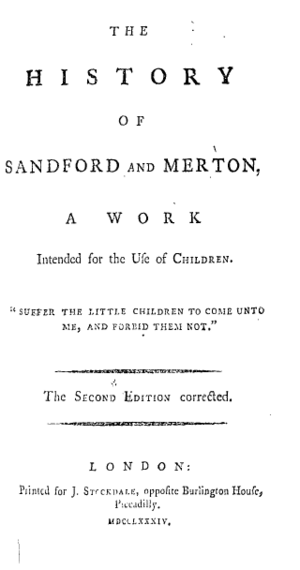The History of Sandford and Merton facts for kids
The History of Sandford and Merton (published between 1783 and 1789) was a very popular children's book. It was written by Thomas Day. He first started it as a short story for another children's book series called Harry and Lucy. This series was put together by Richard Lovell and Honora Sneyd Edgeworth.
Thomas Day later made his short story much longer. It became the first part of The History of Sandford and Merton. This first part was published in 1783 without the author's name. Two more parts came out in 1786 and 1789. The book was a huge success! It was printed many times until the late 1800s. It was so well-known that it even inspired a funny book called The New History of Sandford and Merton. This new book joked that it would "teach you what to don't."
Contents
What is Sandford and Merton?
Even though its title says "history," this book is not a history book like we think of today. Instead, it's a collection of many different stories. Thomas Day wrote some of these stories himself. He also took others from many different places. These stories are loosely connected by a main plot.
The Story of Tommy and Harry
The main story in Sandford and Merton is about a boy named Tommy Merton. Tommy is six years old and very spoiled. His mother and their helpers in the West Indies pampered him a lot. Because of this, Tommy is proud and doesn't know much about the world. The book shows how Tommy changes from a spoiled boy into a good and kind young gentleman. Thomas Day believed that being "virtuous" meant understanding the value of hard work.
Tommy meets Henry (Harry) Sandford, who is a farmer's son. Harry is "plain and honest." He becomes Tommy's role model and teacher in the book. Both boys are guided by a wise mentor, Mr. Barlow.
Thomas Day wanted to highlight all the different stories he had collected. These stories included moral lessons, science facts, and fables. But the book became famous mainly for the story of Tommy and Harry. Many shorter versions of the book were made after Day died. These shorter books focused on the relationship between the two boys. They often removed parts about how children should be educated. For example, Lucy Aikin made a version in 1868 called Sandford and Merton: In Words of One Syllable.
Learning Important Lessons
The book shares many ideas about education and life that Jean-Jacques Rousseau believed in. Thomas Day really admired Rousseau. Sandford and Merton was Day's way of showing Rousseau's ideas to British children through a story.
Harry, the farmer's son, is like a living example of Rousseau's ideas. He doesn't like the fancy, over-the-top way of life that was common then. Tommy Merton and his parents are surprised by Harry. He is not impressed by their fancy food or their many possessions. Harry prefers his own simple life. He enjoys hard work, being good, and simple pleasures. As the story goes on, Tommy starts to understand and adopt these good values too.
Why Was This Book Important?
The History of Sandford and Merton was seen as a book that taught children good morals. It was so well-known that other authors mentioned it. For example, Ethel Turner started her book Seven Little Australians with a warning. She wrote, "If you imagine you are going to read of model children... you had better lay down the book immediately and betake yourself to 'Sandford and Merton'..." This shows how famous the book was for its moral lessons.


